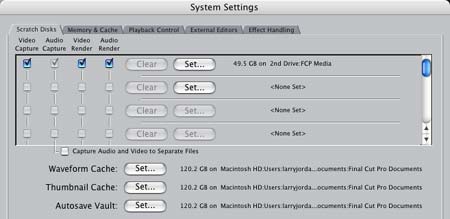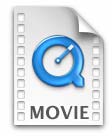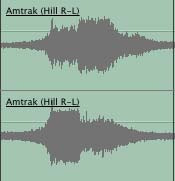There are a variety of files and folders
that Final Cut creates automatically. Here's what they are, where
they are stored and what they do.
All these automatically created folders
and files are related to choices you make when you set your Scratch
Disk, using Final Cut Pro HD > System Settings
Project File.
This is the file that contains all your clips and sequences.
You control what it is named and where it is stored, but, since
it is created by Final Cut, I thought I would mention it here.

When you set your Scratch Disks, Final
Cut creates six folders:
- Capture scratch
- Render files
- Audio render files
- Waveform cache
- Thumbnail cache
- Autosave Vault

The first three files are always stored
together, based upon how you set your scratch disks at the top
of this dialog.

The second three files are set based
upon your selections in the middle of this dialog. Their default
locations is inside the Final Cut Pro documents folder inside
your User folder. While all the files these three create a small,
so their ultimate location doesn't make a real difference, I
tend to locate them in the same location as the first three files.

In all cases, I create a folder on my
second hard drive, called FCP Media, and point all of
these folders to that one location. That makes storing, locating
and removing all files related to a single project simple and
quick. Here's an article that describes this organization
process.
But, I digress. Let's take a look at
the files each of these folders contains.

These first three folders all create
files that use the same icon, and all three folders are stored
together.
Capture scratch.
This contains all the media files you capture with Final Cut.
Audio and video. They are all stored as QuickTime files.
Render files.
These files are created whenever you render a video transition
or effect. They, too, are stored as QuickTime files. The letters
"FIN" in the file name, indicate they are rendered
at the highest possible quality. Using other render quality settings
will alter the file name.
Audio render files. These files are created whenever Final Cut
renders an audio effect, or creates a mix-down. Mix-downs occur
whenever your audio tracks exceed the real-time track limit set
in User Preferences. The default setting is 8 tracks.

These next three folders all create files
that use the same icon, but different from the first three folders.
While these three folders are most often stored together, each
can be stored separately. I make a point to set all six files
to the same place: the FCP Media folder, which I create
on my second hard drive.

Waveform cache.
These files contain the images of your audio waveforms that are
displayed in the audio tracks of the Timeline. It's a good habit
to turn off the display of your waveforms (type Option+Command+W),
unless you are specifically editing audio clips where seeing
the actual waveform on the Timeline helps you decide where to
place the edit point. You'll get faster performance from your
computer that way.

Thumbnail cache.
These files contain the small images of your video clips that
are displayed in the Timeline and the Browser.
Autosave Vault.
These files contain backup copies of your project files so that,
in the event of a crash, you can recover your project more quickly.
You set how often these backups are created in Final Cut Pro
HD > User Preferences. I have my Autosave Vault set to 15
minutes.
Generally, I don't worry about the files
in the AutoSave Vault, Thumbnail Cache or Waveform Cache folders.
The files are small and tend not to get in the way. However,
when I am done with a project, I will always use Tools >
Render Managerto get rid of render files and delete all media
files using the Finder.
Now you know.
This tip is from "Larry's
FCP Newsletter," a very cool FREE monthly Final Cut
Pro newsletter -- subscribe at Larry's website: www.larryjordan.biz.
Larry Jordan is a post-production consultant and an Apple-Certified
Trainer in Digital Media with over 25 years experience as producer,
director and editor with network, local and corporate credits.
Based in Los Angeles, he's a member of both the Directors Guild
and Producers Guild.
Text copyright 2004, by
Larry Jordan. All rights reserved.